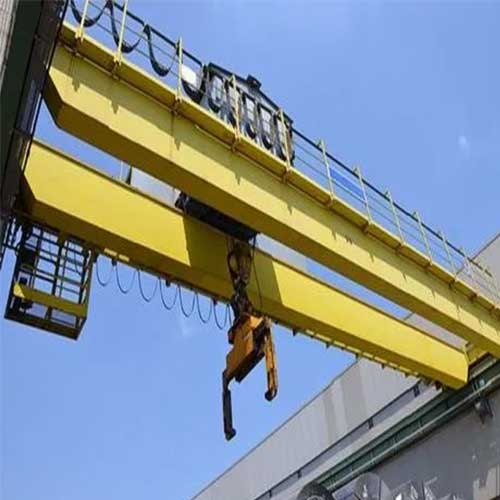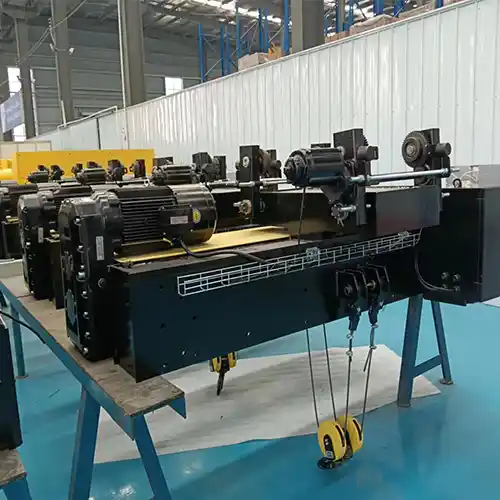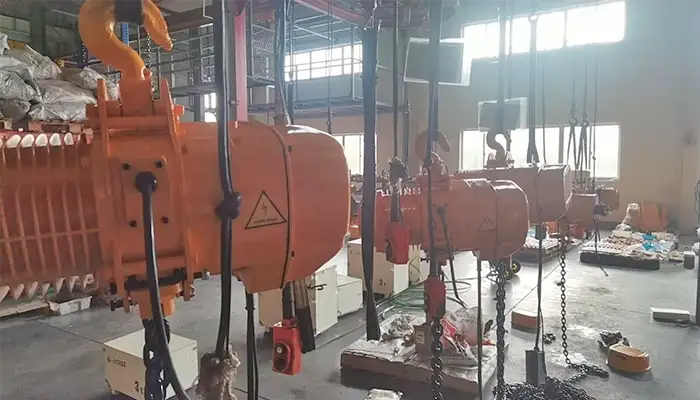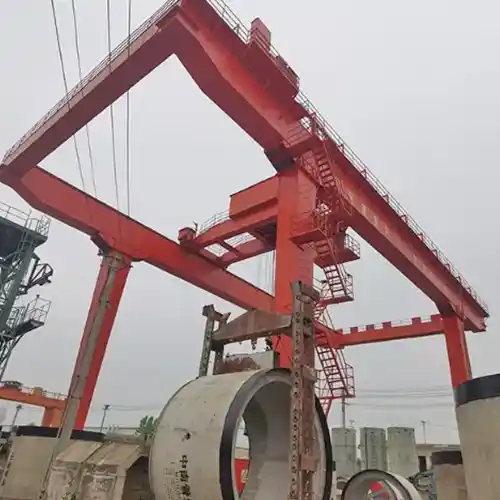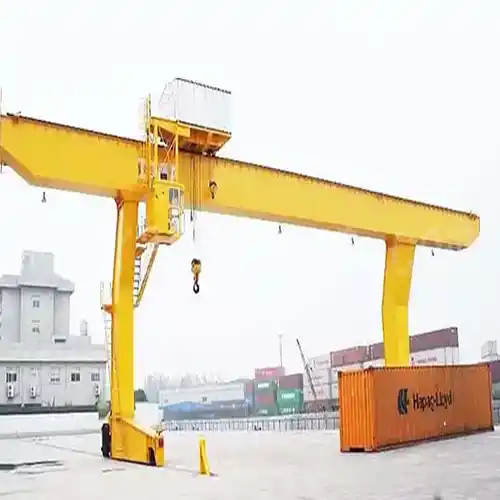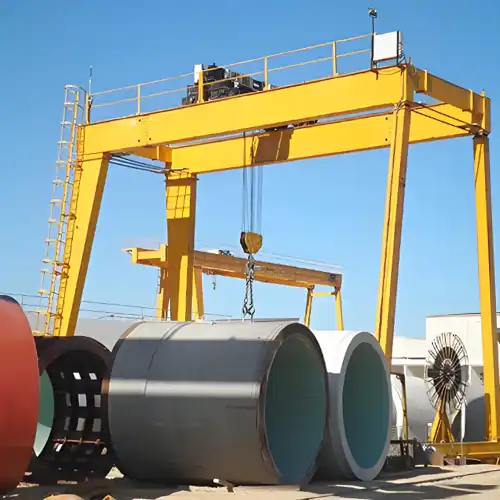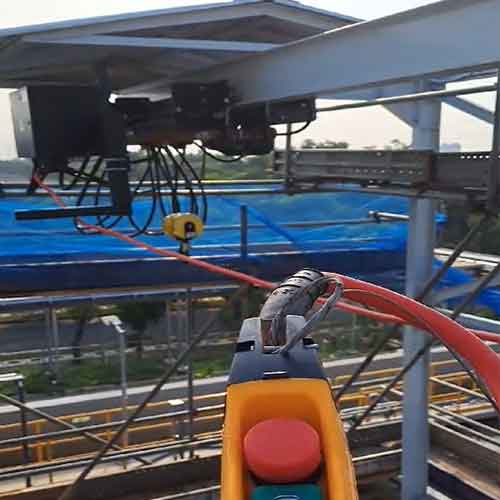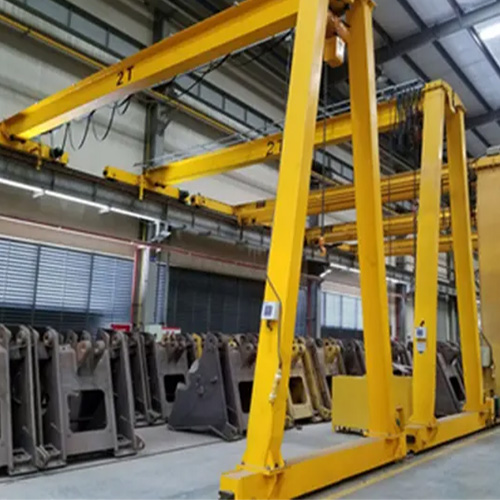Selecting Right Outdoor Crane: Outdoor Overhead Cranes vs. Outdoor Gantry Cranes
Outdoor overhead cranes vs outdoor gantry cranes. The choice between an overhead crane & a gantry crane depends on factors, i.e, specific application, available space & mobility.
Category: Overhead Crane for Your Use
Your Trusted Outdoor Crane Manufacturer & Supplier
Selecting Right Outdoor Crane: Outdoor Overhead Cranes vs. Outdoor Gantry Cranes
Outdoor overhead cranes vs outdoor gantry cranes. The choice between an overhead crane & a gantry crane depends on factors, i.e, specific application, available space & mobility.
Selecting the Right Outdoor Crane for Material Handling: A Comprehensive Guide
Outdoor cranes are robust and powerful lifting equipment designed for material handling in outdoor environments. These industrial machines play a pivotal role in various sectors, offering the capability to lift, move, and position heavy loads with precision. The two primary types of outdoor cranes are outdoor overhead cranes and outdoor gantry cranes.
Outdoor Overhead Cranes: These cranes are characterized by their horizontal bridge spanning the width of the working area, with a hoist and trolley mechanism for lifting and moving loads. They are typically mounted on elevated runways, providing a fixed path for movement.
Outdoor Gantry Cranes: Gantry cranes, on the other hand, feature a framework of vertical legs on both sides, forming a gantry that supports the horizontal bridge. This design offers increased stability and allows for mobility along tracks or wheels.
Importance of Outdoor Cranes in Material Handling
The significance of outdoor cranes in material handling cannot be overstated. These machines are instrumental in streamlining operations across various industries. Key reasons for their importance include:
- Heavy Load Handling: Outdoor cranes excel in lifting and transporting heavy materials, such as steel beams, containers, and machinery, which would be challenging or impossible to handle manually.
- Efficiency and Productivity: By automating material handling processes, outdoor cranes contribute to increased efficiency and productivity. They facilitate the swift movement of goods, reducing downtime and optimizing workflow.
- Versatility: Outdoor cranes are versatile in their applications, catering to a wide range of industries, including construction, manufacturing, shipping, and more. Their adaptability makes them indispensable in dynamic work environments.
- Precision and Control: The design of outdoor cranes, especially overhead cranes, allows for precise positioning of loads. This precision is crucial in industries where accuracy is paramount.
- Safety: The use of outdoor cranes enhances workplace safety by minimizing the need for manual lifting and reducing the risk of accidents associated with heavy material handling.
As we delve deeper into the world of outdoor cranes, it becomes evident that selecting the right type of crane is crucial for ensuring optimal performance in specific applications. In the following sections, we will explore the characteristics of outdoor overhead cranes and outdoor gantry cranes, providing insights into their designs, applications, and considerations for selection. Join us on this journey to make an informed choice when it comes to outdoor material handling solutions.
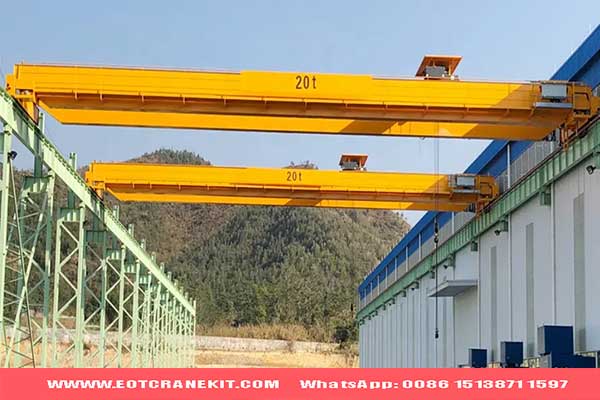
Outdoor Overhead Cranes
Outdoor overhead cranes are engineering marvels designed for precision and efficiency in material handling. The key features include a horizontal bridge that spans the width of the working area, equipped with a hoist and trolley mechanism. This design allows for vertical and horizontal movement, providing versatility in load handling.
- Support Structure The support structure of outdoor overhead cranes is typically an elevated runway or framework. This overhead support allows for unobstructed movement of the crane along a fixed path. The elevated design optimizes the use of space in outdoor environments.
- Mobility and Movement While overhead cranes follow a fixed path along the runway, their mobility is unmatched within that defined space. The hoist and trolley system provides precise control, allowing for efficient load positioning and movement.
Types of Outdoor Cranes:
Outdoor overhead cranes are versatile and robust material handling solutions designed for a wide range of applications in open air environments. These cranes are commonly used in industries such as construction, manufacturing, shipping, and logistics, where the need for lifting and transporting heavy loads is prevalent. The primary advantage of outdoor overhead cranes is their ability to efficiently move loads horizontally and vertically, covering a designated workspace with precision and reliability.
There are several main types of outdoor overhead cranes, each catering to specific needs. Single girder outdoor bridge cranes feature a lightweight design suitable for moderate loads, while double girder cranes offer higher lifting capacities for heavy duty applications. Top running cranes operate on rails attached to the top of the building structure, maximizing floor space, while underhung cranes are suspended from the ceiling, providing flexibility in movement without floor obstructions. Free standing cranes offer independent support, making them ideal for outdoor spaces without existing building structures.
In addition to these main types, specialized outdoor overhead cranes cater to unique requirements. Grab bucket cranes are equipped for efficient bulk material handling, magnetic cranes handle magnetic materials like iron and steel, and double hook cranes enhance productivity by lifting and handling multiple loads simultaneously. These specialized variants demonstrate the adaptability of outdoor overhead cranes to diverse industrial needs.
Outdoor overhead cranes play a crucial role in streamlining material handling processes, improving efficiency, and enhancing workplace safety. Their robust construction and ability to withstand outdoor conditions make them essential tools in various industries, contributing to the seamless movement of goods and materials in challenging environments.
Let's explore the main types of outdoor overhead cranes and their specialized counterparts, along with their typical designs, features, and applications:
Main Types of Outdoor Overhead Cranes:
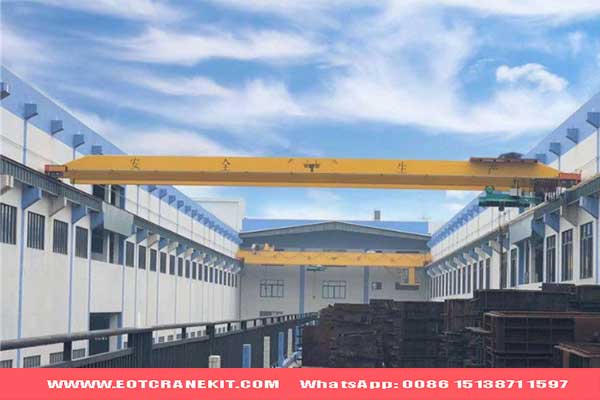
Single Girder Outdoor Bridge Crane:
Design: Features a single horizontal girder supported by end trucks on each side.
Features: Economical, lightweight design suitable for light to moderate loads and shorter spans.
Typical Applications: Small to medium sized outdoor material handling tasks in warehouses, construction sites, and manufacturing facilities.

Double Girder Outdoor Bridge Crane:
Design: Utilizes two horizontal girders for increased load capacity and stability.
Features: Suitable for heavier loads and longer spans compared to single girder cranes. Offers higher lifting capacities.
Typical Applications: Heavy duty outdoor material handling in shipyards, construction sites, and industrial facilities.
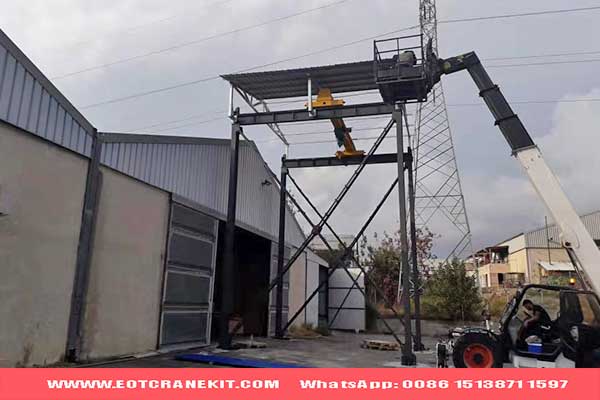
Free Standing Outdoor Bridge Cranes:
Design: Independent support structure, not relying on building columns or roof support.
Features: Offers flexibility in placement without the need for building support. Ideal for outdoor applications.
Typical Applications: Outdoor yards, loading docks, and areas without existing building structures.
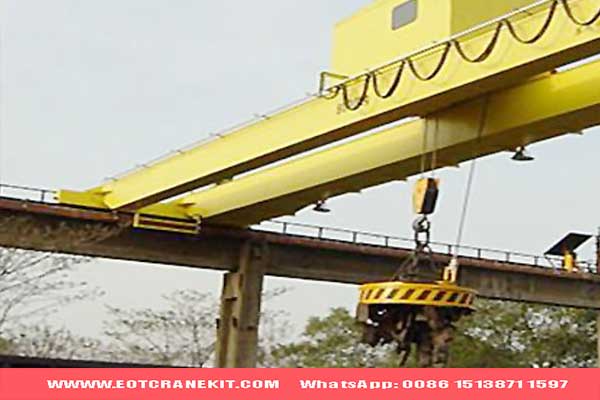
Magnetic Outdoor Overhead Cranes:
Design: Utilizes an electromagnetic lifting system for handling magnetic materials.
Features: Capable of lifting and transporting materials like iron and steel without the need for additional attachments.
Typical Applications: Metal processing plants, scrap yards, and steel manufacturing facilities.

Double Hook Outdoor Bridge Cranes:
Design: Features two hooks for simultaneous lifting and handling of multiple loads.
Features: Increases efficiency by handling multiple loads concurrently.
Typical Applications: Industries with high throughput requirements, such as shipping yards and material processing facilities.
When selecting an outdoor overhead crane, considerations should include load capacity, span, operational environment, and specific material handling requirements to ensure optimal performance and safety.
Typical Applications
Outdoor bridge cranes find widespread applications across various industries, playing a pivotal role in efficiently handling heavy loads and enhancing material handling processes in open air environments. These cranes are designed to withstand outdoor conditions and are employed in diverse applications to streamline operations.
In construction sites, outdoor bridge cranes are utilized for lifting and moving heavy materials such as steel beams, concrete panels, and construction equipment. Their ability to cover large areas and lift substantial loads makes them indispensable in the construction industry, contributing to faster and more efficient project completion.
Manufacturing facilities leverage outdoor bridge cranes for tasks such as loading and unloading raw materials, transporting work in progress materials within the facility, and moving finished products to storage or shipping areas. The cranes' versatility and ability to handle varying load sizes make them essential in optimizing production workflows.
Shipping yards and ports benefit from outdoor bridge cranes for the efficient loading and unloading of containers onto ships or trucks. These cranes facilitate the movement of heavy cargo, contributing to the smooth and timely operation of maritime logistics.
In warehouses and distribution centers, outdoor bridge cranes are employed for tasks like stacking and retrieving goods from storage areas. The ability to cover a wide workspace and handle heavy pallets or containers makes these cranes crucial in optimizing warehouse logistics.
Mining and material processing industries use outdoor bridge cranes for bulk material handling. Grab bucket cranes, a specialized type of outdoor bridge crane, are often employed in mining operations to efficiently move and transport materials like coal, ore, or aggregates.
Overall, outdoor bridge cranes are versatile tools that enhance efficiency, productivity, and safety across various industries where heavy material handling is a fundamental aspect of operations. Their robust design, adaptability to different environments, and capacity to handle diverse loads make them essential equipment in outdoor applications, contributing to the seamless flow of materials in challenging and dynamic settings.

Specific Type: Double Girder Overhead Crane
Design and Configuration:
Features two horizontal girders that support the hoist and trolley mechanism.
Sturdy construction to handle heavy loads.
High lifting capacities and wide spans.
Typical Applications:
Lifting and positioning steel beams, concrete blocks, and other construction materials.
Efficiently moving and placing components during construction projects.
Functions:
Precise lifting and lowering of heavy loads.
Horizontal movement along the fixed runway for accurate positioning.
Places Installed:
Construction sites with large and heavy construction materials.
Infrastructure projects requiring the movement of substantial loads.

Manufacturing Facilities: Handling Large Components and Finished Products
Specific Type: Single Girder Overhead Crane
Design and Configuration:
Utilizes a single horizontal girder for support.
Suitable for lighter to moderate lifting capacities.
Versatile and adaptable for various manufacturing applications.
Typical Applications:
Handling large components in the manufacturing process.
Moving and positioning finished products on production lines.
Functions:
Precise lifting and movement within manufacturing facilities.
Supporting assembly and production processes.
Places Installed:
Automotive manufacturing plants.
Aerospace and machinery production facilities.

Storage Yards: Organizing and Managing Heavy Materials in Outdoor Storage Areas
Specific Type: Top Running Crane
Design and Configuration:
Single girder design for versatility.
Mounted on top of the runway beam.
Can cover a large area in outdoor storage yards.
Typical Applications:
Organizing and rearranging heavy materials in storage yards.
Efficient management of materials in open air storage areas.
Functions:
Handling and repositioning heavy materials.
Transporting loads across the storage yard.
Places Installed:
Construction material yards.
Outdoor storage facilities for bulk materials.

Steel Mills and Foundries: Crucial for Handling Raw Materials and Finished Metal Products
Specific Type: Clamp crane and Magnet Crane (Electromagnetic Overhead Crane)
Design and Configuration:
Equipped with an electromagnetic lifting mechanism.
Specialized for handling metal materials with magnetic properties.
Double girder design for stability and high capacity.
Typical Applications:
Lifting and transporting raw metal materials in steel mills.
Moving and positioning finished metal products in foundries.
Functions:
Magnetic lifting for efficient handling of metal materials.
Precise control for positioning heavy metal products.
Places Installed:
Steel mills for handling raw metal.
Foundries for processing and shaping metal products.
These specific types of outdoor overhead cranes are tailored to meet the unique demands of various industries and applications. When selecting an overhead crane for a specific condition, it's essential to consider the design features, lifting capacities, and functions that align with the requirements of the environment and the materials being handled.
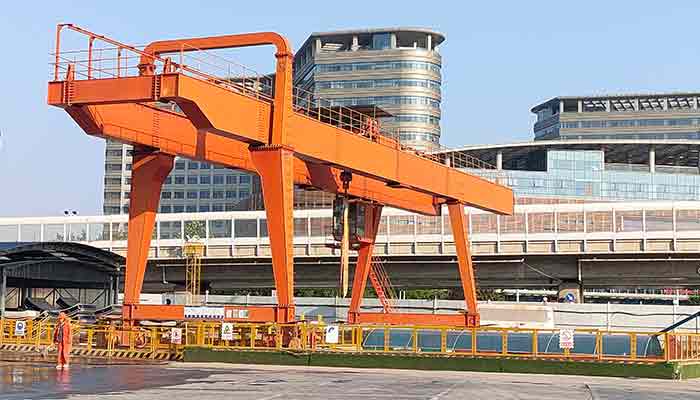
Outdoor Gantry Cranes
Outdoor gantry cranes are characterized by a framework of vertical legs on both sides, forming a gantry that supports the horizontal bridge. This design enhances stability and allows for greater mobility. Gantry cranes can be equipped with wheels or move along tracks.
- Support Structure (Gantry) The gantry structure provides self support for outdoor gantry cranes, eliminating the need for an overhead runway. This makes them adaptable to different outdoor environments and terrains.
- Mobility and Terrain Adaptability Gantry cranes offer enhanced mobility, as they can move along tracks or be equipped with wheels to navigate over uneven terrain. This adaptability makes them suitable for outdoor applications with varied surfaces.
Main Types of Outdoor Gantry Cranes
Outdoor gantry cranes are essential material handling solutions designed for various industries requiring the efficient lifting and movement of heavy loads in open air environments. These cranes are characterized by their sturdy and adaptable design, making them suitable for applications such as construction sites, shipyards, warehouses, and manufacturing facilities. Gantry cranes are distinguished by their horizontal girders that are supported by vertical legs, providing stability and flexibility in load handling.
One of the primary advantages of outdoor gantry cranes is their ability to cover large work areas and handle diverse load sizes and weights. Single girder gantry cranes are cost effective options for lighter loads and shorter spans, while double girder gantry cranes offer increased lifting capacities and stability for heavy duty applications. The truss girder design enhances strength to weight ratios, making them ideal for outdoor tasks that require a balance between load capacity and weight considerations.
Rail mounted gantry cranes move along predefined tracks, providing precise and controlled travel in specific paths. Rubber tyred gantry cranes, on the other hand, offer mobility and adaptability to uneven outdoor surfaces, making them suitable for construction sites and storage yards. Semi gantry cranes, with one end supported by a building structure and the other on wheels or tracks, are advantageous in areas with limited space or specific layout requirements.
Specialized outdoor gantry cranes cater to unique needs, such as grab bucket gantry cranes for efficient bulk material handling, and magnetic gantry cranes for lifting and transporting magnetic materials like iron and steel. These specialized variants showcase the adaptability of outdoor gantry cranes to diverse industrial requirements, contributing to increased efficiency and safety in material handling processes.
Overall, outdoor gantry cranes are indispensable tools in the realm of heavy duty material handling, providing reliability, versatility, and durability for a wide range of applications in challenging outdoor environments. Their ability to handle various loads and navigate different terrains makes them crucial assets in industries where outdoor material handling is a fundamental aspect of operations.
Outdoor gantry cranes come in various types, each designed for specific applications and operational requirements. Here's an overview of the main types you mentioned:
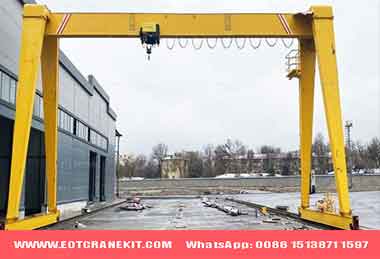
Single Girder Outdoor Gantry Crane:
Design: Consists of a single horizontal girder supported by vertical legs on either side.
Features: Lighter and more economical than double girder cranes. Suitable for lighter loads and shorter spans.
Typical Applications: Small to medium sized outdoor material handling tasks, such as in construction sites, warehouses, and manufacturing facilities.
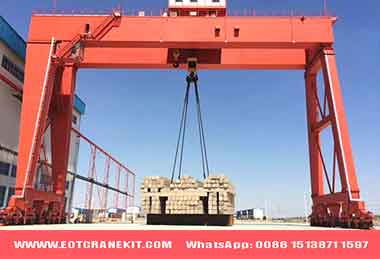
Outdoor Double Girder Gantry Cranes
Design: Utilizes two horizontal girders for increased load capacity and stability.
Features: Offers higher lifting capacities and spans compared to single girder cranes. Suitable for heavier loads and longer spans.
Typical Applications: Heavy duty outdoor material handling in shipyards, construction sites, and industrial facilities.

Truss Girder Outdoor Gantry Crane:
Design: Features a truss type girder structure for enhanced strength and reduced weight.
Features: Offers a good balance between load capacity and weight. Suitable for outdoor applications requiring high strength to weight ratios.
Typical Applications: Construction sites, loading and unloading of containers, and other outdoor material handling tasks.
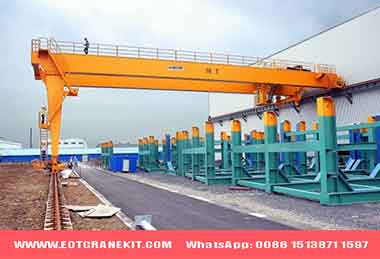
Outdoor Semi Gantry Crane:
Design: Similar to a gantry crane but supported on only one side, with the other end running on a runway or wheels.
Features: Combines features of both gantry and overhead cranes. Can be cost effective and suitable for specific layout requirements.
Typical Applications: Outdoor areas with limited space, loading docks, and warehouses.
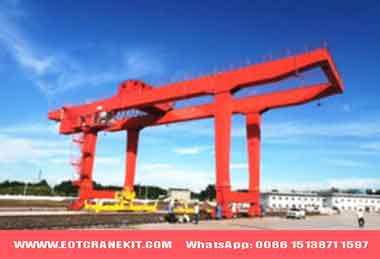
Rail Mounted Outdoor Gantry Crane:
Design: Equipped with wheels running on rails for precise movement.
Features: Offers smooth and controlled travel along a predetermined path. Ideal for applications requiring precise positioning.
Typical Applications: Ports, shipyards, and outdoor facilities where a fixed path for the crane is preferred.
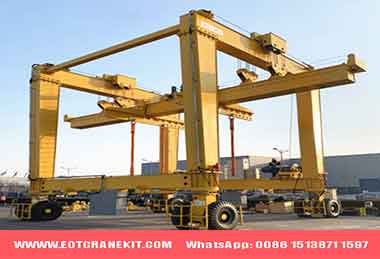
Rubber Tyred Outdoor Gantry Cranes:
Design: Mounted on rubber tires, providing flexibility in movement.
Features: Offers mobility and adaptability to different terrains. Can be moved easily around a site.
Typical Applications: Construction sites, storage yards, and outdoor areas with uneven surfaces.

Double Hook Gantry Cranes:
Design: Equipped with two hooks for lifting and handling two loads simultaneously.
Features: Increased efficiency and productivity in scenarios where multiple loads need to be moved concurrently.
Typical Applications: Found in industries with high throughput requirements, such as shipping yards and material processing facilities.

Variable Gantry Cranes:
Design: Designed with adjustable features to adapt to different load sizes and shapes.
Features: Versatility in handling various loads, as the crane can be adjusted to accommodate different dimensions.
Typical Applications: Suitable for facilities where loads vary significantly in size and shape, offering flexibility in material handling.

Grab Bucket Outdoor Gantry Crane:
Design: Fitted with a grab bucket attached to the hook for efficient bulk material handling.
Features: Specifically designed for bulk material handling applications, such as loading and unloading of loose materials like coal, sand, or gravel.
Typical Applications: Found in industries like mining, shipping, and construction where bulk material handling is a primary requirement.

Magnetic Gantry Cranes:
Design: Equipped with an electromagnetic lifting system for handling magnetic materials.
Features: Capable of lifting and transporting materials such as iron, steel, and other magnetic items without the need for additional attachments.
Typical Applications: Metal processing plants, scrap yards, and steel manufacturing facilities where magnetic materials are prevalent.
Each of these specialized gantry crane types is designed to meet specific industrial needs, offering efficiency and safety in the handling of different types of loads. When selecting a gantry crane, it's crucial to consider the nature of the materials being handled, the operational environment, and the specific requirements of the application to ensure optimal performance and safety.
Typical Applications of outdoor gantry cranes
Outdoor gantry cranes find extensive applications across diverse industries where the efficient handling of heavy loads in open air environments is crucial. These versatile material handling solutions play a pivotal role in various applications, contributing to increased productivity and streamlined operations.
In construction sites, outdoor gantry cranes are utilized for lifting and transporting construction materials such as steel beams, concrete panels, and other heavy components. Their ability to cover large areas and handle substantial loads makes them invaluable in accelerating construction processes and optimizing project timelines.
Shipping yards and ports rely on outdoor gantry cranes for the efficient loading and unloading of containers onto ships or trucks. These cranes play a key role in facilitating the smooth flow of maritime logistics by handling heavy cargo with precision and speed.
Warehouses and distribution centers benefit from outdoor gantry cranes in tasks such as stacking and retrieving goods from storage areas. The cranes' adaptability to handle various load sizes and weights enhances the efficiency of material handling processes, ensuring timely and organized storage operations.
Manufacturing facilities employ outdoor gantry cranes for tasks such as moving raw materials, transporting work in progress materials within the facility, and lifting finished products. Their robust design and versatility make them essential in optimizing production workflows and contributing to overall operational efficiency.
In mining and material processing industries, outdoor gantry cranes, especially those equipped with grab buckets, play a crucial role in bulk material handling. These cranes efficiently move and transport materials such as coal, ore, and aggregates, contributing to the seamless operation of mining and processing operations.
Overall, outdoor gantry cranes are indispensable in applications where heavy material handling is a fundamental aspect of operations. Their ability to cover large workspaces, handle diverse loads, and navigate challenging outdoor environments makes them essential tools for industries ranging from construction and shipping to warehousing and manufacturing.
Outdoor gantry cranes are commonly employed in:
Shipyards: Lifting and placing ship components, containers, and heavy machinery.
Construction Sites: Ideal for construction projects where the crane needs to move along tracks or operate in areas with irregular terrain.
Railway Yards: Handling and organizing cargo in railway yards.
Outdoor Storage: Efficiently managing materials in outdoor storage yards.
Loading Docks: Facilitating loading and unloading operations at warehouses and distribution centers.
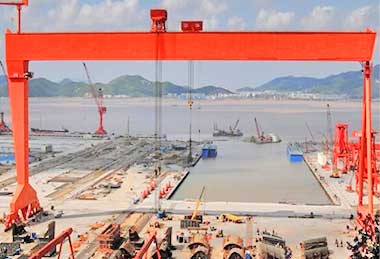
Shipyards: Lifting and Placing Ship Components, Containers, and Heavy Machinery
Specific Type: Ship to Shore Gantry Crane
Design and Configuration:
Tall and robust structure for reaching over ships.
Equipped with a spreader for lifting and placing containers.
Mounted on rails for movement along the shore.
Typical Applications:
Loading and unloading containers and cargo from ships.
Placing ship components and heavy machinery on vessels.
Functions:
Precise lifting and positioning of containers and ship components.
Efficient handling of heavy materials in shipyard operations.
Places Installed:
Seaport shipyards and container terminals.

Construction Sites: Ideal for Construction Projects with Irregular Terrain
Specific Type: Rubber Tired Gantry Crane (RTG)
Design and Configuration:
Equipped with rubber tires for mobility on irregular terrain.
Can move independently without the need for tracks.
Adjustable and adaptable to varying ground conditions.
Typical Applications:
Handling and transporting construction materials on construction sites.
Moving heavy components in areas with uneven surfaces.
Functions:
Versatile mobility for navigating construction sites.
Efficient load handling and placement.
Places Installed:
Construction sites with varying terrain conditions.
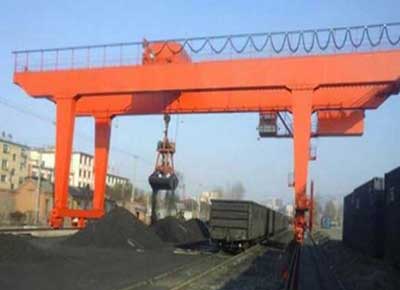
Railway Yards: Handling and Organizing Cargo in Railway Yards
Specific Type: Rail Mounted Gantry Crane (RMG)
Design and Configuration:
Mounted on rails for precise movement along tracks.
Multiple hoisting mechanisms for efficient cargo handling.
Elevated structure to facilitate rail clearance.
Typical Applications:
Organizing and stacking cargo containers in railway yards.
Handling and transferring materials between trains and storage.
Functions:
Horizontal movement along railway tracks.
Stacking and organizing cargo efficiently.
Places Installed:
Railway yards and intermodal facilities.
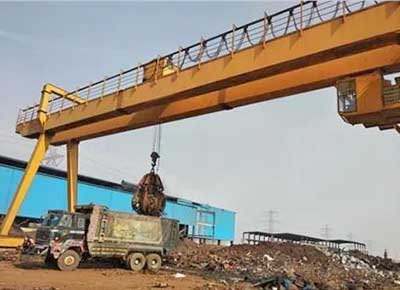
Outdoor Storage: Efficiently Managing Materials in Outdoor Storage Yards
Specific Type: Straddle Carrier
Design and Configuration:
Four legged structure with lifting mechanisms.
Wheels for mobility on outdoor surfaces.
Adjustable legs for efficient container stacking.
Typical Applications:
Efficiently managing and stacking containers in outdoor storage yards.
Transporting heavy materials across storage areas.
Functions:
Straddling containers for lifting and movement.
Versatile mobility for outdoor storage applications.
Places Installed:
Outdoor storage facilities and container yards.

Loading Docks: Facilitating Loading and Unloading Operations at Warehouses and Distribution Centers
Specific Type: Semi Gantry Crane
Design and Configuration:
One side supported by a gantry structure, while the other side moves along a runway.
Suitable for loading and unloading operations at docks.
Compact design for efficient use of space.
Typical Applications:
Facilitating loading and unloading operations at loading docks.
Handling and transferring goods between storage and transportation.
Functions:
Efficient horizontal movement for cargo handling.
Precision in loading and unloading operations.
Places Installed:
Warehouses, distribution centers, and loading docks.
These specific types of outdoor gantry cranes are tailored to meet the diverse demands of various industries and applications. When selecting a gantry crane for a specific condition, it's essential to consider the design features, mobility options, and functions that align with the requirements of the environment and the materials being handled.
Comparisons of Overhead Cranes and Gantry Cranes for Different Outdoor Applications
Construction Sites: Lifting and Moving Heavy Construction Materials
Outdoor Overhead Crane:
Design and Configuration:
Horizontal bridge spanning the width of the working area.
Mounted on elevated runways.
Typical Applications:
Lifting and moving heavy construction materials within a fixed path.
Advantages:
Precise positioning along the fixed runway.
Efficient lifting of heavy loads.
Outdoor Gantry Crane:
Design and Configuration:
Framework of vertical legs forming a gantry to support the horizontal bridge.
Can be equipped with wheels for mobility.
Typical Applications:
Handling construction materials in areas with irregular terrain.
Advantages:
Mobility and adaptability to varied construction site conditions.
Versatility in movement.
Shipping Yards: Loading and Unloading of Containers and Cargo
Outdoor Overhead Crane:
Design and Configuration:
Typically used for specific applications like container handling.
Can have a specialized spreader for container lifting.
Typical Applications:
Loading and unloading containers from ships.
Advantages:
Precise control for container handling.
Effective in shipyard operations.
Outdoor Gantry Crane:
Design and Configuration:
Can be equipped with a spreader for container handling.
Movement along the quay for optimal reach.
Typical Applications:
Loading and unloading containers with mobility along the dock.
Advantages:
Versatile mobility along the shore.
Efficient reach over ships.
Manufacturing Facilities: Handling Large Components and Finished Products
Outdoor Overhead Crane:
Design and Configuration:
Single or double girder design for various lifting capacities.
Fixed path along the overhead runway.
Typical Applications:
Handling large components and finished products within manufacturing plants.
Advantages:
Precise lifting and positioning for assembly processes.
Effective in a controlled manufacturing environment.
Outdoor Gantry Crane:
Design and Configuration:
Single or double girder design with the gantry framework.
Versatile mobility within manufacturing facilities.
Typical Applications:
Handling components with the need for mobility.
Advantages:
Adaptability to different areas within the facility.
Suitable for dynamic manufacturing layouts.
Storage Yards: Organizing and Managing Heavy Materials in Outdoor Storage Areas
Outdoor Overhead Crane:
Design and Configuration:
Top running or underhung design depending on requirements.
Fixed path along elevated runways for organized storage.
Typical Applications:
Organizing and managing heavy materials in outdoor storage yards.
Advantages:
Efficient organization with a fixed path.
Precise positioning of materials.
Outdoor Gantry Crane:
Design and Configuration:
Top running or rubber tired design for mobility.
Flexible mobility for handling materials across the storage yard.
Typical Applications:
Efficiently managing materials in outdoor storage areas.
Advantages:
Versatile mobility for varied storage layouts.
Adaptability to different storage conditions.
Steel Mills and Foundries: Crucial for Handling Raw Materials and Finished Metal Products
Outdoor Overhead Crane:
Design and Configuration:
Double girder design with high lifting capacities.
Suitable for precise handling in demanding environments.
Typical Applications:
Lifting and transporting raw materials and finished metal products.
Advantages:
Precision in handling metal materials.
High lifting capacities for heavy loads.
Outdoor Gantry Crane:
Design and Configuration:
Magnet crane with electromagnetic lifting mechanism for metal materials.
Self supporting gantry structure for stability.
Typical Applications:
Lifting and placing metal materials with magnetic properties.
Advantages:
Magnetic lifting for efficient metal handling.
Stability in challenging environments.
In summary, the choice between outdoor overhead cranes and outdoor gantry cranes depends on specific application requirements. Outdoor overhead cranes are often favored for precise movements along fixed paths, while outdoor gantry cranes provide mobility and adaptability in varying terrain conditions. Both types offer unique advantages, and the selection should be based on factors such as space, mobility needs, and the nature of the materials being handled.
Factors to Consider in Crane Selection:
Choosing the appropriate outdoor crane for your material handling needs involves a detailed evaluation of various factors. Let's delve into practical information and considerations for each crucial factor:
Space and Layout
Outdoor Overhead Crane Considerations
- Runway Requirements: Assess the available space for the installation of an overhead crane's runway. Ensure there is sufficient clearance for the crane's movement without obstruction.
- Elevated Structure: Verify the feasibility of installing an elevated structure for supporting the overhead crane. Consider the impact on existing infrastructure and whether modifications are needed.
Outdoor Gantry Crane Considerations
- Ground Space: Gantry cranes do not require an overhead structure. Evaluate the ground space for the placement of vertical legs and the gantry structure. Ensure the area is suitable for the crane's movement.
- Terrain Adaptability: Gantry cranes can navigate over uneven terrain. Consider the outdoor environment, and assess whether the gantry crane can operate smoothly on the existing ground conditions.
Mobility and Terrain
Outdoor Overhead Crane Considerations
- Fixed Runway Path: Overhead cranes operate along a fixed path defined by the runway. Ensure that the crane's path aligns with the workflow and lifting requirements in the outdoor space.
- Surface Compatibility: Verify that the surface below the runway is suitable for the movement of the crane. Surface irregularities may impact the crane's mobility.
Outdoor Gantry Crane Considerations
- Track or Wheels: Gantry cranes can be equipped with tracks or wheels for mobility. Decide on the most suitable option based on the need for a defined path (tracks) or flexibility over different surfaces (wheels).
- Terrain Analysis: Assess the outdoor terrain for irregularities. Gantry cranes are known for their adaptability, but a thorough analysis helps determine the type of mobility required.
Load Capacity
Capacity of Outdoor Overhead Cranes
- Load Weight: Identify the heaviest loads that the crane will handle. Verify that the overhead crane's capacity meets or exceeds the maximum weight requirements.
- Lifting Height: Consider the vertical distance the crane needs to lift loads. Ensure that the lifting height of the overhead crane aligns with the vertical requirements of the application.
Capacity of Outdoor Gantry Cranes
- Load Distribution: Gantry cranes distribute loads along the gantry structure. Evaluate the load distribution and confirm that the gantry crane's capacity accommodates the load distribution requirements.
- Span Length: Consider the span length of the gantry crane. Verify that it covers the entire working area and can effectively reach the required lifting zones.
Precision and Control
Precision with Outdoor Overhead Cranes
- Hoist and Trolley System: Assess the precision offered by the hoist and trolley system. Precision is crucial for applications where accurate load positioning is required.
- Control Mechanism: Understand the control mechanisms available for the overhead crane. Features such as variable speed controls contribute to precise movements.
Precision with Outdoor Gantry Cranes
- Trolley System: Evaluate the precision of the gantry crane's trolley system. Precision is vital for applications that demand accurate load placement.
- Control Options: Explore the control options available for gantry cranes. Advanced control systems enhance precision in movement and load handling.
Support Structure
Overhead Support for Overhead Cranes
- Runway Strength: Ensure that the overhead support structure (runway) is engineered to handle the weight and dynamic forces imposed by the overhead crane. Verify that it meets safety standards and regulations.
- Installation Considerations: Evaluate the installation process for the overhead support structure. Consider any disruptions to existing operations during installation.
Self Supporting Gantry Structure
- Structural Integrity: Confirm the structural integrity of the self supporting gantry structure. It should provide stability and support for the crane's operations.
- Installation Flexibility: Gantry cranes offer flexibility in installation. Assess whether the gantry structure can be installed without significant impact on existing structures.
Cost Considerations
Installation Costs
- Infrastructure Modifications: Evaluate the costs associated with modifying existing infrastructure to accommodate the chosen crane type. Consider expenses related to the installation of runways or gantry legs.
- Labor Costs: Factor in labor costs for the installation process. Skilled labor may be required for precision work during the installation phase.
Operational Costs
- Maintenance Requirements: Consider the maintenance requirements of the chosen crane type. Assess the frequency and complexity of maintenance tasks, and estimate associated costs.
- Energy Efficiency: Evaluate the energy efficiency of the crane. Energy efficient cranes may contribute to lower operational costs over the crane's lifecycle.
By thoroughly considering these practical aspects, you can make informed decisions when selecting between outdoor overhead cranes and outdoor gantry cranes. In the final section of our guide, we will provide a comprehensive summary of key considerations and encourage you to embark on the journey of integrating the right outdoor crane into your material handling processes.
Application Specific Considerations:
Tailoring Crane Selection to Specific Industry Needs
When it comes to outdoor material handling, one size does not fit all. Tailoring your crane selection to specific industry needs is crucial for optimal performance and efficiency. Consider the following factors to align your choice with the unique requirements of your industry:
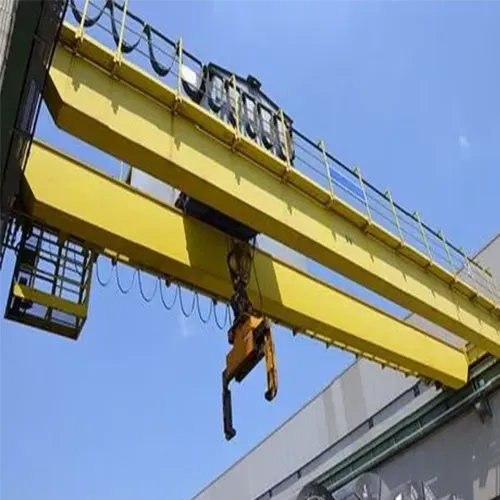
Outdoor Overhead Cranes:
Definition: Outdoor overhead cranes are large, industrial grade machines used for lifting and moving heavy loads in outdoor settings.
Design: They are typically mounted on elevated runways, and the crane's horizontal beam (bridge) spans the width of the area it covers. The hoist and trolley mechanism move along the bridge, allowing for precise positioning of the load.
Applications: Outdoor overhead cranes are commonly used in construction sites, shipping yards, and other outdoor industrial facilities where there is a need to lift and transport heavy materials.
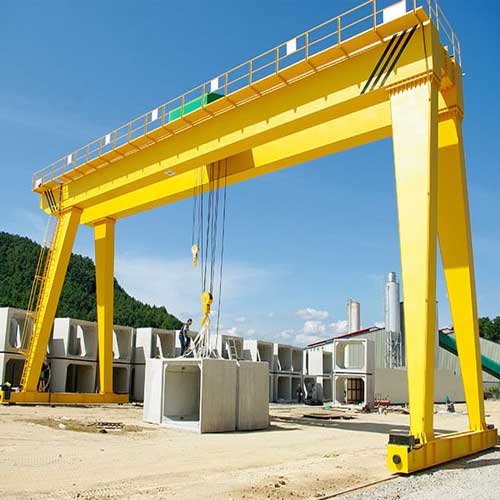
Outdoor Gantry Cranes:
Definition: Outdoor gantry cranes are similar to overhead cranes but are supported by a framework of vertical legs on both sides, forming a gantry. This design provides additional stability and flexibility in terms of movement.
Design: Gantry cranes have a horizontal bridge that spans the area and a hoist and trolley system for lifting and moving loads. The legs of the gantry crane rest on the ground or rails, making them suitable for outdoor use.
Applications: Outdoor gantry cranes are often used in shipyards, construction sites, and other outdoor applications where the crane needs to move along a track or over irregular terrain.
Construction Industry:
Ideal Crane Type: Outdoor Overhead Crane
Rationale: Overhead cranes are well suited for construction sites, providing precise lifting and movement capabilities for heavy construction materials.
Shipping and Cargo Handling:
Ideal Crane Type: Outdoor Overhead Crane
Rationale: Overhead cranes excel in shipping yards, facilitating the loading and unloading of containers and cargo with efficiency and precision.
Manufacturing Facilities:
Ideal Crane Type: Either Outdoor Overhead Crane or Outdoor Gantry Crane
Rationale: Overhead cranes are suitable for fixed paths within manufacturing plants, while gantry cranes offer flexibility in movement.
Storage Yards:
Ideal Crane Type: Outdoor Overhead Crane
Rationale: Overhead cranes are effective for organizing and managing heavy materials in outdoor storage yards.
Metal Processing (Steel Mills and Foundries):
Ideal Crane Type: Outdoor Overhead Crane
Rationale: Overhead cranes are crucial for the handling of raw materials and finished metal products in the demanding environment of steel mills and foundries.
Shipbuilding and Repair Yards:
Ideal Crane Type: Outdoor Gantry Crane
Rationale: Gantry cranes are well suited for shipyards, offering stability and mobility for lifting and placing ship components and heavy machinery.
Railway Yards:
Ideal Crane Type: Outdoor Gantry Crane
Rationale: Gantry cranes are adaptable to railway yards, providing the necessary mobility and terrain adaptability for cargo handling.
Outdoor Storage Facilities:
Ideal Crane Type: Outdoor Gantry Crane
Rationale: Gantry cranes are versatile for managing materials in outdoor storage areas with varied surfaces.
Loading Docks (Warehouses and Distribution Centers):
Ideal Crane Type: Either Outdoor Overhead Crane or Outdoor Gantry Crane
Rationale: Overhead cranes offer precise positioning, while gantry cranes provide mobility for loading and unloading operations.
Examples of Ideal Applications for Each Crane Type
Outdoor Overhead Cranes:
Ideal for applications requiring fixed paths and precise positioning.
Examples: Construction sites, shipping yards, manufacturing facilities with defined layouts.
Outdoor Gantry Cranes:
Suited for applications needing mobility and adaptability to varied terrains.
Examples: Shipbuilding yards, construction sites with irregular terrain, railway yards.
Understanding the specific needs of your industry is pivotal in making an informed decision. In the next section, we will delve into the critical factors to consider when choosing between outdoor overhead cranes and outdoor gantry cranes to ensure that your selection aligns seamlessly with your material handling requirements.
Consultation and Expert Advice:
Importance of Consulting Crane Experts
In the intricate world of outdoor material handling, the importance of consulting crane experts cannot be overstated. While the information provided in this guide offers valuable insights, the unique requirements of your application may benefit from the expertise of professionals in the field. Here's why consulting crane experts is crucial:
- Tailored Solutions: Crane experts can assess your specific needs, considering factors such as load capacity, space constraints, and operational dynamics. This allows for the recommendation of tailored solutions that align with your material handling goals.
- Regulatory Compliance: Crane experts are well versed in industry standards and regulations. Consulting with them ensures that your chosen crane design complies with safety and operational guidelines, minimizing risks and ensuring a smooth workflow.
- Optimized Efficiency: Professionals in the field possess a deep understanding of crane performance and efficiency. Their insights can lead to the selection of a crane type and configuration that maximizes productivity and minimizes downtime.
- Cost Considerations: Crane experts can provide a comprehensive cost analysis, taking into account not only the initial purchase cost but also installation, maintenance, and operational expenses. This holistic view helps in making informed decisions aligned with budgetary considerations.
- Future Proofing: Technology and industry standards evolve. Consulting with crane experts ensures that your selection aligns with current advancements and is future proofed against potential changes in operational requirements.
Collaboration with Crane Manufacturers
Collaborating directly with crane manufacturers offers a direct line to the source of expertise and innovation. Here's why partnering with crane manufacturers is beneficial:
- In Depth Product Knowledge: Manufacturers possess in depth knowledge of their crane designs. Collaborating with them allows for a thorough understanding of product specifications, capabilities, and customization options.
- Customization Possibilities: Crane manufacturers can tailor their designs to meet your specific needs. Whether it's adjusting load capacities, incorporating specific features, or adapting to unique working conditions, manufacturers can provide customized solutions.
- Warranty and Support: Partnering with crane manufacturers ensures access to warranty programs and ongoing support. This is crucial for addressing any issues that may arise during the crane's lifecycle, providing peace of mind and reliability.
- Installation and Training: Manufacturers often offer installation services and training programs for crane operators. This ensures that the crane is set up correctly and that your team is well equipped to operate it safely and efficiently.
- Direct Communication: Collaboration with crane manufacturers allows for direct communication channels. This facilitates a smoother process from initial consultations to the final implementation, ensuring that your requirements are clearly understood and addressed.
In conclusion, the expertise of crane professionals and collaboration with manufacturers are integral components of the decision making process. In the final section, we will summarize key considerations and encourage readers to make informed decisions when selecting the right outdoor crane for their material handling needs.
Wrap it Up: Custom Outdoor Cranes for Your Needs
As we conclude this comprehensive guide to selecting the right outdoor crane for material handling, let's recap the key considerations that will empower you to make an informed decision:
- Understanding Crane Types: Distinguish between outdoor overhead cranes and outdoor gantry cranes based on their designs, support structures, mobility, and typical applications.
- Factors for Selection: Consider space and layout, mobility requirements, load capacity, precision and control needs, support structures, and cost considerations when choosing between crane types.
- Application Specific Tailoring: Tailor your crane selection to the specific needs of your industry, whether it's construction, shipping, manufacturing, or storage. Each industry may benefit from a specific type of crane.
- Consultation with Experts: Recognize the importance of consulting with crane experts who can provide tailored solutions, ensure regulatory compliance, optimize efficiency, consider cost factors, and future proof your material handling operations.
- Collaboration with Manufacturers: Collaborate directly with crane manufacturers for in depth product knowledge, customization possibilities, warranty and support, installation services, and direct communication channels.
Selecting the right outdoor crane is a critical decision that can significantly impact the efficiency and safety of your material handling operations. We encourage you to take the time to thoroughly assess your specific needs, consult with experts, and collaborate with reputable crane manufacturers. By doing so, you not only ensure that the chosen crane aligns seamlessly with your requirements but also set the foundation for a robust and reliable material handling system.
Remember, the investment in the right outdoor crane is an investment in the success and productivity of your operations. Whether it's the precision of an overhead crane or the versatility of a gantry crane, each type has its unique advantages. Make informed decisions, and may your choice lead to streamlined operations, enhanced safety, and the successful achievement of your material handling goals.
Thank you for embarking on this journey with us. If you have any further questions or require additional guidance, feel free to reach out to crane experts or manufacturers who can provide personalized assistance. Here's to the seamless integration of outdoor cranes into your material handling processes!
Main Projects
Related Products

Latest project
32/5 Ton Overhead Crane Sale in India: Case Study
Free consultation to Confirm Parameters & Specifications and Get
Latest Crane Price & Crane Rate.
- Types of overhead cranes : _______?
- Optional: Overhead travelling crane, goliath gantry crane,Slewing jib crane, Single girder or double girder crane,small portable crane or kbk crane, etc.
- Capacity of overhead crane: _______?
- Optional: 0.25ton, 0.5 ton, 1 ton, 2 ton, 3ton, 5 ton, 10 ton,15ton, 20ton, 25 ton, 30ton,35ton, up to 550ton, etc.
- Crane span & lifting height : _______?
- Crane travelling length : _____?
- Control of overhead crane:_______?
- Optional: pendant/ remote/cabin control
- Voltage supply of overhead crane:_____?
- Eg,: 380V50/60HZ,3Phase or others,etc.
- Application/usage of crane:_______?
- Eg,: Steel mill, ,injection mold, cement,stone, concrete,granite, general manufacturing, etc.
Just leave a message via the contact form and our hoist and crane engineer will contact you with in 24working hours.
Get In Touch
